
The Rise of Sensor Networks and IoT
The Internet of Things (IoT) has revolutionized the way we interact with the world around us. At the heart of this transformation lie sensor networks – intricate webs of interconnected devices that collect, process, and transmit vast amounts of data. From smart homes to industrial automation, sensor networks have become essential for powering a wide range of IoT applications.
However, as the demand for real-time, ubiquitous monitoring continues to grow, the challenge of energy efficiency has emerged as a critical concern. IoT devices are often battery-powered or have limited energy resources, making power management a crucial aspect of sensor network design.
Adaptive Sampling: Optimizing Data Collection
One of the key strategies for improving energy efficiency in IoT monitoring is adaptive sampling. This approach involves dynamically adjusting the sampling rate and resolution of sensor data based on changing environmental conditions or the specific needs of the application.
By intelligently adapting the sampling parameters, IoT systems can reduce the overall data volume while still capturing the essential information required for decision-making. This not only conserves battery life but also minimizes the bandwidth needed for data transmission, further contributing to energy savings.
Recent research has explored various techniques for adaptive sampling, such as leveraging machine learning algorithms to predict optimal sampling rates or using statistical models to identify relevant data patterns. These data-driven approaches enable IoT systems to adapt to changing conditions in real-time, ensuring that energy is utilized efficiently without compromising the quality of the collected data.
Compression Techniques: Reducing Data Loads
Alongside adaptive sampling, data compression plays a crucial role in energy-efficient IoT monitoring. By reducing the size of sensor data before transmission, IoT devices can minimize the energy-intensive process of wireless data transfer.
Lossless compression algorithms, such as Huffman coding or arithmetic coding, can effectively shrink data without losing any information. This allows IoT systems to transmit the same amount of data using less bandwidth, leading to significant energy savings.
More advanced lossy compression techniques, on the other hand, can further reduce data size by selectively discarding non-essential information. Wavelet-based compression and compressive sensing are examples of such lossy compression methods that have been successfully applied in IoT sensor network environments.
Researchers have demonstrated that the combination of adaptive sampling and data compression can collectively enhance the energy efficiency of IoT monitoring systems by up to 80% compared to traditional approaches.
Balancing Quality and Energy Savings
While adaptive sampling and data compression offer compelling energy-saving benefits, it is crucial to strike a balance between data quality and power consumption. IoT applications often have specific requirements regarding the accuracy, timeliness, and granularity of the collected data, and compromising these factors can have adverse consequences.
Adaptive sampling, for instance, needs to be designed carefully to maintain the necessary level of data fidelity required by the application. Overly aggressive reduction in sampling rates or resolution can lead to loss of critical information, potentially undermining the effectiveness of the IoT system.
Similarly, data compression techniques must be tailored to the application’s needs, balancing the degree of compression with the acceptable level of data distortion. Lossless compression is often preferred for mission-critical applications, while lossy compression may be more suitable for non-critical or delay-tolerant use cases.
Adaptive algorithms that dynamically adjust the sampling and compression parameters based on real-time conditions and application requirements can help IoT systems optimize the trade-off between energy efficiency and data quality.
Securing IoT Sensor Networks
As sensor networks become increasingly ubiquitous, security has emerged as a paramount concern. IoT devices, often deployed in distributed and uncontrolled environments, are vulnerable to a wide range of cyber threats, from unauthorized access to data tampering and denial-of-service attacks.
Robust security measures are essential to protect the integrity and confidentiality of the sensor data, as well as to safeguard the critical infrastructure that IoT systems support. Encryption, authentication, and access control are just a few of the security mechanisms that must be carefully integrated into the design of sensor networks**.
Sensor Networks is at the forefront of advancing IoT security, leveraging cutting-edge cryptographic techniques and decentralized architectures to enhance the resilience of sensor networks against evolving cyber threats.
Energy Management in IoT Ecosystems
Energy management is a multifaceted challenge in the IoT ecosystem, as sensor networks are often geographically dispersed and require reliable, long-term operation without the need for frequent battery replacements or recharging.
Strategies for energy-efficient IoT monitoring go beyond just adaptive sampling and data compression. Innovative power management techniques, such as energy harvesting, duty-cycling, and load balancing, are being actively explored to further optimize the energy consumption of IoT devices.
Energy harvesting, for instance, leverages ambient energy sources, such as solar, wind, or thermal gradients, to recharge the batteries or directly power the IoT devices, reducing their reliance on finite energy resources.
Duty-cycling, on the other hand, involves the strategic activation and deactivation of sensor nodes based on their specific roles and energy requirements, ensuring that critical components are operational while non-essential parts are conserving power.
Load balancing algorithms can distribute the computational and communication workload across the sensor network, preventing the premature depletion of individual nodes and optimizing the overall energy utilization.
The Future of Sensor Networks and IoT
As the demand for real-time, ubiquitous monitoring continues to grow, the future of sensor networks and IoT is poised to be increasingly dynamic and energy-efficient.
Adaptive sampling, data compression, security measures, and advanced energy management strategies will play a pivotal role in unlocking the full potential of IoT technology, enabling robust, reliable, and sustainable sensor networks that seamlessly integrate with our everyday lives.
Innovations in artificial intelligence, edge computing, and 5G/6G communications will further enhance the capabilities of sensor networks, empowering them to adapt to changing conditions, optimize resource utilization, and deliver unprecedented insights that drive the next wave of technological advancements.
The evolution of sensor networks and IoT is a captivating journey, where energy efficiency, security, and adaptability are the cornerstones of a more connected, intelligent, and sustainable future.